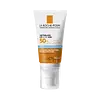What's inside
What's inside
 Key Ingredients
Key Ingredients

 Benefits
Benefits

 Concerns
Concerns

 Ingredients Side-by-side
Ingredients Side-by-side

Water
Skin ConditioningMethylene Bis-Benzotriazolyl Tetramethylbutylphenol
UV FilterCaprylic/Capric Triglyceride
MaskingTris-Biphenyl Triazine
UV AbsorberZinc Oxide
Cosmetic ColorantSqualane
EmollientDipropylheptyl Carbonate
EmollientC12-15 Alkyl Benzoate
AntimicrobialBis-Ethylhexyloxyphenol Methoxyphenyl Triazine
Skin ConditioningDecyl Glucoside
CleansingPropylene Glycol
HumectantGlycerin
Humectant3-O-Ethyl Ascorbic Acid
Skin ConditioningPolyhydroxystearic Acid
EmulsifyingSodium Polyacrylate
AbsorbentButylene Glycol
HumectantDisodium Phosphate
BufferingCentella Asiatica Extract
CleansingNiacinamide
SmoothingTranexamic Acid
AstringentTocopheryl Acetate
AntioxidantPhenoxyethanol
PreservativeXanthan Gum
EmulsifyingEthylhexylglycerin
Skin ConditioningCamellia Sinensis Leaf Extract
AntimicrobialBifida Ferment Lysate
Skin ConditioningHydrolyzed Yeast Protein
Skin ConditioningPentylene Glycol
Skin ConditioningMadecassoside
AntioxidantPalmitoyl Tripeptide-1
Skin ConditioningPalmitoyl Tetrapeptide-7
Skin ConditioningSodium Hyaluronate
HumectantBeta-Glucan
Skin ConditioningAnthemis Nobilis Flower Extract
MaskingOlea Europaea Leaf Extract
PerfumingBisabolol
MaskingCeramide NP
Skin ConditioningCarbomer
Emulsion StabilisingPolysorbate 20
EmulsifyingSilica
AbrasiveIron Oxides
Water, Methylene Bis-Benzotriazolyl Tetramethylbutylphenol, Caprylic/Capric Triglyceride, Tris-Biphenyl Triazine, Zinc Oxide, Squalane, Dipropylheptyl Carbonate, C12-15 Alkyl Benzoate, Bis-Ethylhexyloxyphenol Methoxyphenyl Triazine, Decyl Glucoside, Propylene Glycol, Glycerin, 3-O-Ethyl Ascorbic Acid, Polyhydroxystearic Acid, Sodium Polyacrylate, Butylene Glycol, Disodium Phosphate, Centella Asiatica Extract, Niacinamide, Tranexamic Acid, Tocopheryl Acetate, Phenoxyethanol, Xanthan Gum, Ethylhexylglycerin, Camellia Sinensis Leaf Extract, Bifida Ferment Lysate, Hydrolyzed Yeast Protein, Pentylene Glycol, Madecassoside, Palmitoyl Tripeptide-1, Palmitoyl Tetrapeptide-7, Sodium Hyaluronate, Beta-Glucan, Anthemis Nobilis Flower Extract, Olea Europaea Leaf Extract, Bisabolol, Ceramide NP, Carbomer, Polysorbate 20, Silica, Iron Oxides
Water
Skin ConditioningDiisopropyl Sebacate
EmollientAlcohol Denat.
AntimicrobialEthylhexyl Salicylate
UV AbsorberEthylhexyl Triazone
UV AbsorberBis-Ethylhexyloxyphenol Methoxyphenyl Triazine
Skin ConditioningDiisopropyl Adipate
EmollientPEG-8
HumectantDipropylene Glycol
HumectantC12-22 Alkyl Acrylate/Hydroxyethylacrylate Copolymer
StabilisingGlycerin
HumectantDrometrizole Trisiloxane
UV AbsorberAluminum Starch Octenylsuccinate
AbsorbentButyl Methoxydibenzoylmethane
UV AbsorberMethoxypropylamino Cyclohexenylidene Ethoxyethylcyanoacetate
StabilisingSilica
AbrasiveTocopherol
AntioxidantDiethylamino Hydroxybenzoyl Hexyl Benzoate
UV FilterAcrylates Copolymer
Acrylates/C10-30 Alkyl Acrylate Crosspolymer
Emulsion StabilisingCaprylyl Glycol
EmollientHydroxyacetophenone
AntioxidantPentaerythrityl Tetra-Di-T-Butyl Hydroxyhydrocinnamate
AntioxidantSodium Polyacrylate
AbsorbentTerephthalylidene Dicamphor Sulfonic Acid
UV AbsorberTriethanolamine
BufferingTrisodium Ethylenediamine Disuccinate
Water, Diisopropyl Sebacate, Alcohol Denat., Ethylhexyl Salicylate, Ethylhexyl Triazone, Bis-Ethylhexyloxyphenol Methoxyphenyl Triazine, Diisopropyl Adipate, PEG-8, Dipropylene Glycol, C12-22 Alkyl Acrylate/Hydroxyethylacrylate Copolymer, Glycerin, Drometrizole Trisiloxane, Aluminum Starch Octenylsuccinate, Butyl Methoxydibenzoylmethane, Methoxypropylamino Cyclohexenylidene Ethoxyethylcyanoacetate, Silica, Tocopherol, Diethylamino Hydroxybenzoyl Hexyl Benzoate, Acrylates Copolymer, Acrylates/C10-30 Alkyl Acrylate Crosspolymer, Caprylyl Glycol, Hydroxyacetophenone, Pentaerythrityl Tetra-Di-T-Butyl Hydroxyhydrocinnamate, Sodium Polyacrylate, Terephthalylidene Dicamphor Sulfonic Acid, Triethanolamine, Trisodium Ethylenediamine Disuccinate
 Reviews
Reviews

Ingredients Explained
These ingredients are found in both products.
Ingredients higher up in an ingredient list are typically present in a larger amount.
You might know this ingredient as Tinosorb S or Bemotrizinol. It is a UV filter that covers both UVA and UVB rays.
This ingredient has two peak UV absorption peaks ( 310 and 340 nm) and is able to absorb both UV-A and UV-B rays. This ingredient works by preventing UV rays from reaching and damaging your skin.
On top of that - it is highly photostable and helps prevent the photodegration of other sunscreen ingredients such as avobenzone.
Tinosorb S is allowed in the EU, Australia, and Asia. It is close to being approved by the FDA and we'll hopefully get this ingredient in the U.S. by late 2025.
Fun fact: Tinosorb S is the most effective UV absorber at maximum concentration (measured by SPF) permitted in the EU.
This ingredient is oil-soluble, so your oil-cleansers will take this right off at night.
Learn more about Bis-Ethylhexyloxyphenol Methoxyphenyl TriazineGlycerin is already naturally found in your skin. It helps moisturize and protect your skin.
A study from 2016 found glycerin to be more effective as a humectant than AHAs and hyaluronic acid.
As a humectant, it helps the skin stay hydrated by pulling moisture to your skin. The low molecular weight of glycerin allows it to pull moisture into the deeper layers of your skin.
Hydrated skin improves your skin barrier; Your skin barrier helps protect against irritants and bacteria.
Glycerin has also been found to have antimicrobial and antiviral properties. Due to these properties, glycerin is often used in wound and burn treatments.
In cosmetics, glycerin is usually derived from plants such as soybean or palm. However, it can also be sourced from animals, such as tallow or animal fat.
This ingredient is organic, colorless, odorless, and non-toxic.
Glycerin is the name for this ingredient in American English. British English uses Glycerol/Glycerine.
Learn more about GlycerinSilica, also known as silicon dioxide, is a naturally occurring mineral. It is used as a fine, spherical, and porous powder in cosmetics.
Though it has exfoliant properties, the function of silica varies depending on the product.
The unique structure of silica enhances the spreadability and adds smoothness, making it a great texture enhancer.
It is also used as an active carrier, emulsifier, and mattifier due to its ability to absorb excess oil.
In some products, tiny microneedles called spicules are made from silica or hydrolyzed sponge. When you rub them in, they lightly polish away dead skin layers and enhance the penetration of active ingredients.
Learn more about SilicaSodium Polyacrylate is the sodium salt of polyacrylic acid. It is used as an absorber, emollient, and stabilizer.
This ingredient is a super-absorbent polymer - meaning it can absorb 100 to 1000 times its mass in water. As an emollient, Sodium Polyacrylate helps soften and soothe skin. Emollients work by creating a barrier to trap moisture in. This helps keep your skin hydrated.
Water. It's the most common cosmetic ingredient of all. You'll usually see it at the top of ingredient lists, meaning that it makes up the largest part of the product.
So why is it so popular? Water most often acts as a solvent - this means that it helps dissolve other ingredients into the formulation.
You'll also recognize water as that liquid we all need to stay alive. If you see this, drink a glass of water. Stay hydrated!
Learn more about Water